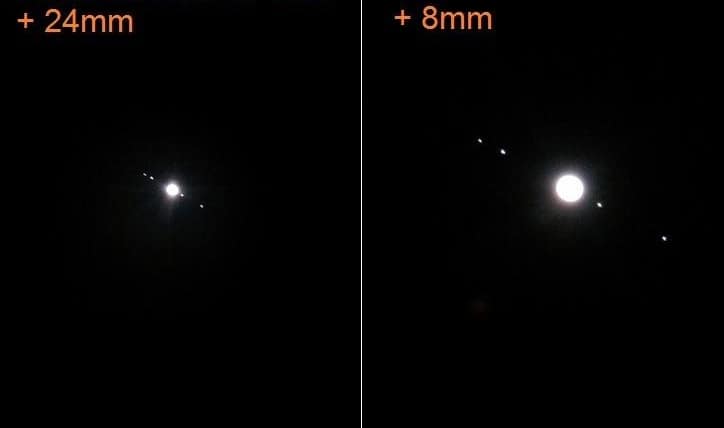Eyepieces can make or break your enjoyment of using your telescope. A zoom eyepiece can be a valuable tool for astronomers, especially beginners who like to get the most out of their money. But how do they compare to a set of good Plossl eyepieces?
A zoom-able eyepiece typically comes in a range of 8mm to 24mm, quickly adjusting for the best magnification. A quality Zoom lens can be an advantage over standard eyepieces. However, a set of Plossl’s with a wider field of view, like 68 degrees can quickly outperform a zoom eyepiece.
The Key Question with Eyepieces
“Zoom” means an eyepiece with an adjustable focal length, and therefore, also adjusting the magnification. Zoom eyepieces are very convenient because there is no need for multiple eyepieces and the need to continually change them. Every time you want to increase or decrease magnification, you turn the grip, not hunt and gripe.
Because of this flexibility and convenience of use, beginners should start using this to save money over buying several quality eyepieces. Also, this allows the beginner to get a good feel on how different magnifications and sizes of eyepieces work with their telescope before buying individual eyepieces.
The most common type of zoomable telescope eyepieces available on the market today are the size 8-24mm types. This means that you can change focal length from 8mm to 24mm.
What Makes A Zoomable Telescope Eyepiece
The zoomable telescope eyepiece usually comes in a bigger tube than other types of eyepieces. Changing the focal length is done by rotating its body. Its body also comes with graduation markings to let you know how much rotation is needed for every value of focal length.
When choosing a zoom telescope eyepiece to use, there are other features to look for aside from the focal length range. These features to look for are the degrees of field of view (FOV), eye relief, filter threads to be able to add any filter that you may want to use.
Some zoomable telescope eyepieces also have t-ring threads to connect your camera using a T-ring adapter.
Do You Lose Quality Over a Normal Eyepiece
Zoomable telescope eyepieces can work with different values of focal lengths, but it comes with a price of being optically inferior to a fixed focal length lens. However, this difference between the quality of the image may be small and not even noticed.
This is even more so the case for beginners, just starting with this hobby or those that are using lower quality telescopes. Now with high-quality zoom telescope eyepieces, an astronomer would need a medium to a high-end telescope and some years of experience to notice much of any difference.
How Do They Compare With Plossl’s
A Plossl eyepiece is one of the most decent general-purpose eyepieces that are available on the market. Compared with a zoomable telescope eyepiece, they are pretty much the same in terms of the quality of the image. Also, they have a FOV of around 50 to 55 degrees which is about the same of standard zoomable telescope eyepieces which is 40 to 60 degrees.
As I touched on earlier about FOV when buying eyepieces the wider the FOV, the better. If you have the wallet for it, moving up to 68 degrees FOV in a zoom eyepiece is better. When jumping to Plossl’s moving up to an 82 degree will give a more significant experience.
What Is The Expected Price Range
The price range of zoomable telescope eyepieces can range from $15 to $300 depending on the quality and the available features. Of course, the 68-degree FOV zoom eyepieces are at the higher end.
Like this Baader Mark IV on Amazon. This is the top-end zoom eyepiece.
There are a lot of good quality zoom eyepieces in the typical 40 to 60 FOV and buying a reputable manufacturer is the better idea when shopping for one. These guys start in around the mid $50’s and can go higher based on lens quantity and coatings. Check this page on Amazon for what they have on zoom eyepieces
Overall Advantage of Zoom Over a Multiple Eyepiece Collection
With a zoomable telescope eyepiece, you will be able to instantly change the magnification in your telescope without physically changing your eyepiece. Since a typical zoom telescope eyepiece allows up to 5 different magnifications, it would be equivalent to needing 5 different eyepieces for their different magnifications.
When you buy a telescope and only received one or two eyepieces. This is the best use for a zoom eyepiece I feel, especially if they are not quality Plossl’s. This allows a user to see which sizes they get the most out of and then can upgrade to Super Plossl’s as the time comes.
This is often the case when, or if you buy a used telescope, but even some new telescopes do not come with super Plossl’s or Gold series eyepieces.
You see most astronomers usually fall back to their couple favorites anyway only using 2 or 3 out of their collection most of the time.
Need More?
Astronomy is a fascinating and rewarding hobby to pursue. It also requires a lot of learning on your part. Hopefully, that is not discouraging, and you find the tips and tricks you need to learn how to get the best out of your scope.
These couple articles would probably be useful to read as well if you are learning about eyepieces.
Astronomy Formulas Explained With Sample Equations



